
TNU Journal of Science and Technology
229(03): 119 - 126
http://jst.tnu.edu.vn 119 Email: jst@tnu.edu.vn
RESEARCH ON THE CURRENT SITUATION AND DEMOGRAPHIC FACTORS
AFFECTING THE SELF-ESTEEM AND WELL-BEING OF
HIGH SCHOOL STUDENTS IN HO CHI MINH CITY
Luu Tang Phuc Khang1*, Nguyen Minh Khang1, Pham Dam Nam Phuong1
Hoang Ngoc Anh Minh1, Truong Vinh2, Nguyen Ngoc Hoang Long3, Tran Thi Phuong Dung4
1Vietnam Australia International School, 2International School Ho Chi Minh City
3High School for the Gifted - National University of Ho Chi Minh City
4Ho Chi Minh City University of Education
ARTICLE INFO
ABSTRACT
Received:
19/10/2023
This article presents a comprehensive assessment of self-esteem and well-being among
high school students in Ho Chi Minh City using a questionnaire interview method. A 5-
point Likert scale was employed to evaluate the perceptions of self-esteem and well-
being. Data were collected through 1,300 distributed questionnaires, yielding a response
rate of 97.08%, resulting in 1,262 valid survey questionnaires. The survey findings
revealed that the overall average scores of self-esteem assessments consistently achieved
level 3 or higher, with a substantial proportion reaching level 4, showcasing a positive
self-perception among the students. Notably, statistical analysis highlighted a significant
difference in self-esteem between male and female students. Furthermore, an analysis of
self-esteem based on grade levels indicated a progressive increase in self-esteem scores
as students advanced from lower to higher grades, underlining the influence of age and
approaching adulthood on self-perception. Male students exhibited slightly higher self-
esteem scores compared to their female counterparts, aligning with existing research that
indicates a minor gender disparity in self-esteem. Gender-wise, female students exhibited
a higher level of well-being than male students, possibly indicating differences in
cognitive awareness and mental health concern. Additionally, a variation in well-being
across different grade levels was observed, potentially reflecting the evolving cognitive
and emotional states of students as they progress through high school.
Revised:
18/01/2024
Published:
18/01/2024
KEYWORDS
High school Student
Self-esteem
Well-being
Demographic
Current status
NGHIÊN CỨU THỰC TRẠNG VÀ CÁC YẾU TỐ NHÂN KHẨU HỌC
TÁC ĐỘNG ĐẾN LÒNG TỰ TRỌNG VÀ MỨC ĐỘ HẠNH PHÚC
CỦA HỌC SINH TRÊN ĐỊA BÀN THÀNH PHỐ HỒ CHÍ MINH
Lưu Tăng Phúc Khang1*, Nguyễn Minh Khang1, Phạm Đàm Nam Phương1
Hoàng Ngọc Ánh Minh1, Trương Vinh2, Nguyễn Ngọc Hoàng Long3, Trần Thị Phương Dung4
1Trường Tiểu học - THCS – THPT Việt Úc, 2Trường Quốc tế Hồ Chí Minh
3Trường Phổ thông Năng khiếu – Đại học Quốc gia Thành phố Hồ Chí Minh
4Trường Đại học Sư phạm Thành phố Hồ Chí Minh
THÔNG TIN BÀI BÁO
TÓM TẮT
Ngày nhận bài:
19/10/2023
Bài viết này trình bày đánh giá về lòng tự trọng và hạnh phúc của học sinh trung học phổ
thông tại Thành phố Hồ Chí Minh bằng phương pháp phỏng vấn bảng câu hỏi. Thang đo
Likert 5 điểm được sử dụng để đánh giá nhận thức về lòng tự trọng và hạnh phúc. Dữ liệu
được thu thập thông qua 1.300 bảng câu hỏi phát tán, đạt tỷ lệ phản hồi là 97,08%, thu
được 1.262 bảng câu hỏi khảo sát hợp lệ. Kết quả khảo sát cho thấy điểm trung bình tổng
thể của các bài đánh giá lòng tự trọng luôn đạt cấp độ 3 hoặc cao hơn, với tỷ lệ đáng kể
đạt cấp độ 4, cho thấy sự tự nhận thức tích cực của học sinh. Đáng chú ý, phân tích
thống kê nêu bật sự khác biệt đáng kể về lòng tự trọng giữa sinh viên nam và nữ. Hơn
nữa, một phân tích về lòng tự trọng dựa trên các cấp lớp cho thấy sự gia tăng dần dần về
điểm số về lòng tự trọng khi học sinh tiến từ lớp thấp lên lớp cao hơn, nhấn mạnh ảnh
hưởng của tuổi tác và sự trưởng thành đối với sự tự nhận thức. Học sinh nam có điểm số
về lòng tự trọng cao hơn một chút so với các học sinh nữ, phù hợp với nghiên cứu hiện
tại cho thấy có sự chênh lệch nhỏ về lòng tự trọng giữa các giới tính. Xét về mặt giới
tính, học sinh nữ thể hiện mức độ hạnh phúc cao hơn học sinh nam, điều này có thể cho
thấy sự khác biệt trong nhận thức và mối quan tâm về sức khỏe tâm thần. Ngoài ra, kết
quả nghiên cứu còn cho thấy sự khác biệt về sức khỏe giữa các cấp lớp khác nhau, có khả
năng phản ánh trạng thái nhận thức và cảm xúc đang phát triển của học sinh trung học.
Ngày hoàn thiện:
18/01/2024
Ngày đăng:
18/01/2024
TỪ KHÓA
Học sinh THPT
Lòng tự trọng
Mức độ hạnh phúc
Nhân khẩu học
Thực trạng
DOI: https://doi.org/10.34238/tnu-jst.9006
* Corresponding author. Email: ltpkhcmue@gmail.com

TNU Journal of Science and Technology
229(03): 119 - 126
http://jst.tnu.edu.vn 120 Email: jst@tnu.edu.vn
1. Introduction
Emotional and behavioral problems (EBPs) have been identified as a major public health
concern in industrialized nations over the past 25 years, alongside physical health complaints [1].
EBPs are associated with an increased risk of adverse later-life outcomes, such as depression,
impaired social relationships, and substance abuse, as well as increased financial costs to society
due to criminal activity, additional educational support, and social care [1] – [3]. As a result,
preventing EBPs and promoting emotional, social, and spiritual well-being is now a national
priority for children and young people in all countries worldwide, including Vietnam. While the
definition of mental illness in childhood and adolescence has been extensively studied,
definitions of mental well-being are less well-developed. In adults, mental well-being is
conceptualized as encompassing both hedonic (happiness, subjective well-being) and eudaimonic
(positive functioning) well-being [4]. In 2004, the Royal Society in the UK defined well-being as
"a positive and sustainable mental state that allows individuals, groups, and nations to thrive and
flourish." Mental well-being, which is conceptualized as more than just the absence of mental
illness, appears to be protective against a variety of health outcomes, including self-rated general
survival health [5], immune response, stress response [1], and predictors of cardiovascular
disease [1], [6]. Mental well-being has also been linked to higher educational attainment in
childhood and adolescence, as well as enhanced vocational functioning in adulthood [1].
Self-esteem stands as a pivotal construct tightly linked to various favorable psychological
outcomes, encompassing psychological adaptation, positive affect, and prosocial conduct [7].
Empirical investigations have underscored that individuals with diminished self-esteem
encounter a heightened frequency of negative emotions compared to their high self-esteem
counterparts [8]. Elevated self-esteem functions as a protective barrier, mitigating anxiety and
bolstering coping mechanisms, ultimately fostering both physical and mental well-being [9]. It
engenders a positive emotional state through facilitating personal adjustment and shielding
against stressors and adverse emotions, whereas diminished self-esteem aligns with depressive
tendencies, anxiety, and a lack of adaptability [10]. Numerous scholarly inquiries have
substantiated the association between self-esteem and well-being [11].
Drawing upon the antecedent rationale and extant scholarly works delineating the positive
influence of mindfulness on self-esteem [12] and the established linkage between self-esteem and
overall well-being [13], it can be posited that mindfulness is predictive of heightened levels of
self-esteem, consequently fostering an augmentation of well-being. This prognostication holds
the potential to inform the development of targeted interventions by researchers and practitioners,
particularly in the context of the burgeoning information technology landscape and the
burgeoning emphasis on mental health and self-focus. While earlier investigations predominantly
centered on scrutinizing perceived self-esteem and well-being in the realm of adulthood, scant
attention has been accorded to the analogous exploration within the cohort of high school
students. Thus, this study was undertaken to appraise the extant condition of self-esteem and
well-being among high school students in Ho Chi Minh City, with the aim of enriching the
theoretical framework essential for proposing pragmatic solutions and heightening awareness of
this pertinent issue among high school students in Ho Chi Minh City.
2. Methods
2.1. Scale construction
The self-esteem assessment instrument utilized in this study was adopted from prior research
conducted by Rosenberg [14] and Gnambs et al. [15] (labeled from SE1 to SE10). The
measurement tool assessing well-being was adapted from earlier research by Boyce et al. [16]
and subsequently refined by Clarke et al. [17] (labeled from WB1 to WB14).

TNU Journal of Science and Technology
229(03): 119 - 126
http://jst.tnu.edu.vn 121 Email: jst@tnu.edu.vn
2.2. Survey methods
This study involved surveying high school students in Ho Chi Minh City, focusing on
understanding the expressions and functions of self-esteem and well-being. The research design
adopted for this study was descriptive survey research. The study area is Ho Chi Minh City, and
the population comprised high school students. Simple random sampling technique was
employed. Data were collected through 1,300 distributed questionnaires, yielding a response rate
of 97.08%, resulting in 1,262 valid survey questionnaires. The sample size determination formula
by Taro Yamane [18]was used to objectively determine a sample size of 1,262 for the study.
Details regarding the participants involved in the survey are outlined in Table 1.
Table 1. Demographic characteristics
Individuals characteristics
Number (n)
Frequency (%)
Sex
Male
490
38.8
Female
772
61.2
Grade
10
453
35.9
11
400
31.7
12
409
32.4
2.3. Survey methods
Upon data collection, the unsatisfactory answer sheets were filtered out, and subsequent data
encoding and entry were executed using Excel software. The amassed data underwent processing
employing SPSS software, involving two primary analytical approaches: (i) employing
descriptive statistical techniques encompassing key indicators such as mean, standard deviation,
minimum and maximum values, among others. The descriptive statistics employed in this study
encompassed mean (average score), Std. Deviation (standard deviation); (ii) Utilizing inferential
statistical methodologies, specifically Independent sample t-Test for gender variable, and One-
Way ANOVA for grade variable, both at a 5% significance level (p < 0.05).
3. Result and discussion
3.1. Survey results on self-esteem of high school students in Ho Chi Minh City
3.1.1. Current status
The outcomes of the survey as shown in Figure 1 indicate that the highest overall student
agreement rate, marked as level 4 (agree), across all observed variables related to self-esteem,
ranged from 21.20% to 38.40%. Furthermore, the assessment rate at levels 4 and above was
notably significant, ranging from 48.90% to 64.80%. Simultaneously, approximately 15.30% to
31.40% of students provided evaluations at levels 1 and 2. Among these, three variables (SE4,
SE9, SE6) exhibited notably high evaluation rates at levels 1 and 2, with rates of 22.40%,
28.60%, and 31.40%, respectively.
Percentage (%) of evaluation
020 40 60 80 100
Variables
SE1
SE2
SE3
SE4
SE5
Strongly disagree
Disagree
Neither agree or disagree
Agree
Strongly agree
Percentage (%) of evaluation
020 40 60 80 100
Variables
SE6
SE7
SE8
SE9
SE10
Figure 1. Current status of self-esteem of high school students in Ho Chi Minh City

TNU Journal of Science and Technology
229(03): 119 - 126
http://jst.tnu.edu.vn 122 Email: jst@tnu.edu.vn
Furthermore, Figure 1 reveals that the average self-esteem assessment scores consistently
reached level 3 or higher, with the majority attaining level 4. Among the observed variables,
"SE8. I wish I respected myself more" garnered the highest average score of 3.68, highlighting a
self-neglect trend among contemporary students. This result is believed to stem from the
multifaceted pressures students face, encompassing economic concerns, familial responsibilities,
academic demands, and overall well-being. Conversely, manifestations of lower self-esteem were
apparent in variables "SE6. Sometimes I feel really worthless" and "SE9. In short, I tend to think
that I am a failure" with average scores of 3.15 and 3.25, respectively.
3.1.2. Demographic factors
Table 2. Statistical testing of the difference in self-esteem of students
Variables
Sex
Grade
Male
Female
10
11
12
SE1
3.75 ± 1.22
3.12 ± 1.12*
3.21 ± 1.08a
3.30 ± 1.31a
3.94 ± 1.12b
SE2
3.55 ± 1.16
3.18 ± 1.25*
3.19 ± 1.12a
3.33 ± 1.37b
3.68 ± 1.07c
SE3
3.72 ± 1.16
3.29 ± 1.11*
3.23 ± 1.06a
3.51 ± 1.19b
3.87 ± 1.12c
SE4
3.55 ± 1.10
3.08 ± 1.16*
3.08 ± 1.05a
3.33 ± 1.18b
3.64 ± 1.14c
SE5
3.61 ± 1.11
3.14 ± 1.18*
3.19 ± 1.07a
3.33 ± 1.25a
3.70 ± 1.08b
SE6
3.36 ± 1.36
2.86 ± 1.33*
2.83 ± 1.26a
3.11 ± 1.48b
3.50 ± 1.26c
SE7
3.56 ± 1.16
3.30 ± 1.14*
3.13 ± 1.14a
3.58 ± 1.31b
3.61 ± 1.16b
SE8
3.79 ± 1.12
3.53 ± 1.22*
3.66 ± 1.13ab
3.58 ± 1.23a
3.81 ± 1.14b
SE9
3.54 ± 1.20
2.85 ± 1.32*
2.86 ± 1.26a
3.09 ± 1.31b
3.79 ± 1.14c
SE10
3.75 ± 1.09
3.23 ± 1.20*
3.24 ± 1.12a
3.51 ± 1.23b
3.83 ± 1.08c
Total
3.61 ± 1.17
3.16 ± 1.22*
3.16 ± 1.15a
3.37 ± 1.28b
3.74 ± 1.14c
Note: Data are presented as Mean ± Std. The letters a, b, c in the same row indicate the ANOVA statistical
difference for the class variable, the letter * in the same row indicates the t-Test statistical difference for
the gender variable in level of statistical significance (p < 0.05).
The results from Table 2 showed within the examined variables pertaining to self-esteem, the
average score range for male students varied from 3.36 to 3.37. Conversely, among female
students, the observed variables concerning self-esteem spanned from 2.85 to 3.30. Across all
facets of self-esteem, male students consistently received higher assessment scores compared to
their female counterparts, and this disparity was statistically significant (p < 0.05). The overall
average self-esteem score for male students was 3.61, surpassing that of female students (3.16),
and this difference was statistically significant (p < 0.05). These findings align with earlier
research suggesting a higher level of self-esteem in males compared to females [19]. Bleidorn et
al. [20] similarly identified notable gender disparities in self-esteem, with males consistently
exhibiting higher levels of self-esteem across all surveyed countries, and both genders displaying
an upward trajectory with age from late adolescence to middle age. This implies that normative
differences in self-esteem related to gender and age are, to some extent, influenced by universal
mechanisms. These mechanisms may encompass biological factors underpinned by genetic
processes transcending various cultures and contexts. However, only a limited number of studies
have explored biological origins, such as hormonal influences, contributing to gender differences
in self-esteem [21]. Notably, several studies have demonstrated a positive correlation between
male traits and self-esteem in both men and women, while the association between female traits
and self-esteem is considerably weaker and less consistent [22], [23].
Results of a one-way ANOVA analysis reveal discernible differences among class levels
concerning the observed self-esteem variables. Specifically, grade 12 students display a
predominant majority of assessment scores ranging from 3.50 to 3.94, surpassing those of grade
10 and 11 students, and this disparity holds statistical significance (p < 0.05). Assessment scores
on the observed variables for 11th-grade students exceeded those of 10th-grade students, ranging
from 3.09 to 3.58 compared to 2.83 to 3.24. The cumulative assessment scores across the three

TNU Journal of Science and Technology
229(03): 119 - 126
http://jst.tnu.edu.vn 123 Email: jst@tnu.edu.vn
grades, arranged from lowest to highest, are as follows: grade 12 students (3.74), grade 11
students (3.37), and grade 10 students (3.16). The average assessment scores exhibited statistical
variance among the three grades (p < 0.05). Time emerges as a significant factor in altering or
redirecting life trajectories, impacting behaviors, emotions, cognitions, and contexts, and is also
relevant to an individual's evolving perception of self-esteem [24]. For instance, during early and
middle adulthood, individuals engage in diverse societal roles, such as students participating in
clubs, NGOs, and similar entities. These roles associated with societal engagement can impart a
sense of self-worth and potentially elevate self-esteem [25]. Notably, successful mastery of
challenges linked to initial employment can enhance a young person's sense of mastery and,
consequently, elevate self-esteem [26].
3.2. Survey results on well-being of high school students in Ho Chi Minh City
3.2.1. Current status
Percentage (%) of evaluation
020 40 60 80 100
Variables
WB1
WB2
WB3
WB4
WB5
WB6
WB7
Strongly disagree
Disagree
Neither agree or disagree
Agree
Strongly agree
Percentage (%) of evaluation
020 40 60 80 100
Variables
WB8
WB9
WB10
WB11
WB12
WB13
WB14
Figure 2. Current status of well-being of high school students in Ho Chi Minh City
The survey results showed from Figure 2 revealed that the highest overall student agreement
rate, denoted as level 4 (agree), across all observed self-esteem variables, ranged from 26.50% to
44.90%. Furthermore, the evaluation rate of students at levels 4 and above ranged from 45.60%
to 71.20%. Concurrently, approximately 11.80% to 25.20% of students provided evaluations at
levels 1 and 2. Among these, four variables (WB6, WB9, WB10, and WB11) exhibited notably
high evaluation rates at levels 1 and 2, with rates of 21.40%, 21.50%, 22.30%, and 25.20%,
respectively. The average self-esteem assessment scores consistently attained level 3 or higher,
with the majority achieving level 4. Among the observed variables, the variable "WB13. I’ve
been interested in new things" received the highest average score of 3.87, indicating a positive
inclination toward discovering new aspects about oneself. Students' expressions of lower
evaluation were observed in “WB10. I’ve been feeling confident” which attained an average
score of 3.31. This could be attributed to the academic pressures and demands of the current
period impacting the ratings for WB10.
3.2.2. Demographic factors
The research outcomes reveal variations in well-being assessment scores between male and
female students. In most observed variables from Table 3, assessment scores of female students
surpass those of male students, demonstrating a statistically significant difference (p < 0.05).
However, two observed variables, WB4 and WB13, do not exhibit statistical disparities between
male and female students (p > 0.05). The overall average score illustrates that female students
perceive a higher level of well-being in comparison to male students (3.73 compared to 3.31),
and this distinction is statistically significant (p < 0.05). Earlier research findings indicate that





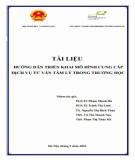
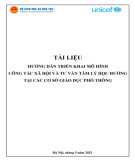

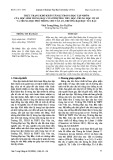
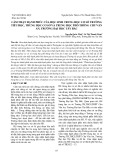
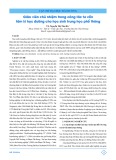


![Câu hỏi ôn tập Tâm lý học quản lý [chuẩn nhất]](https://cdn.tailieu.vn/images/document/thumbnail/2025/20251125/hathunguyen04er@gmail.com/135x160/25191764124376.jpg)
![Cẩm nang chăm sóc và nuôi dạy trẻ tăng động giảm chú ý [chuẩn nhất]](https://cdn.tailieu.vn/images/document/thumbnail/2025/20251118/kimphuong1001/135x160/4241763431998.jpg)


![Sổ tay Hướng dẫn tự chăm sóc trầm cảm [chuẩn nhất]](https://cdn.tailieu.vn/images/document/thumbnail/2025/20251029/kimphuong1001/135x160/3711761720335.jpg)
![Đề cương Tâm lý học xã hội [chuẩn nhất]](https://cdn.tailieu.vn/images/document/thumbnail/2025/20251028/c.dat0606@gmail.com/135x160/99271761707421.jpg)
![Câu hỏi ôn thi Nhập môn khoa học nhận thức [chuẩn nhất]](https://cdn.tailieu.vn/images/document/thumbnail/2025/20251021/aduc03712@gmail.com/135x160/48471761019872.jpg)

![Đề cương môn Tâm lý học sinh tiểu học [chuẩn nhất]](https://cdn.tailieu.vn/images/document/thumbnail/2025/20251007/kimphuong1001/135x160/51781759830425.jpg)



![Tâm lí học lứa tuổi và sư phạm ở tiểu học: Bài thuyết trình [chuẩn nhất]](https://cdn.tailieu.vn/images/document/thumbnail/2025/20250918/vuhoaithuong14@gmail.com/135x160/90941758161117.jpg)
